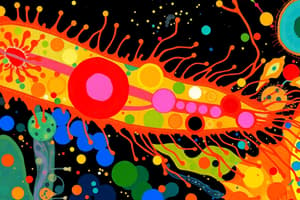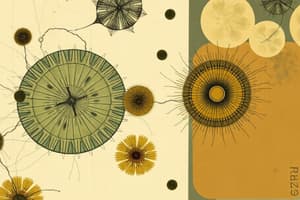Podcast
Questions and Answers
Which group of protozoans is characterized by their ability to move and capture prey using pseudopodia?
Which group of protozoans is characterized by their ability to move and capture prey using pseudopodia?
- Ciliated protozoans
- Amoeboid protozoans (correct)
- Dinoflagellates
- Flagellated protozoans
What is the primary distinguishing feature of flagellated protozoans?
What is the primary distinguishing feature of flagellated protozoans?
- Capability of forming spores
- Presence of flagella (correct)
- Presence of cilia
- Use of pseudopodia
What type of environment do slime moulds primarily thrive in?
What type of environment do slime moulds primarily thrive in?
- Moist environments (correct)
- Aquatic habitats
- High-salinity conditions
- Dry, arid environments
Which of the following is a characteristic of dinoflagellates?
Which of the following is a characteristic of dinoflagellates?
Which protozoan example is known for causing sleeping sickness?
Which protozoan example is known for causing sleeping sickness?
Euglena is classified as which type of protozoan?
Euglena is classified as which type of protozoan?
Which protozoan is most notorious for its role in causing malaria?
Which protozoan is most notorious for its role in causing malaria?
Which characteristic distinguishes ciliated protozoans from other protozoan groups?
Which characteristic distinguishes ciliated protozoans from other protozoan groups?
What role do diatoms primarily play in their marine environment?
What role do diatoms primarily play in their marine environment?
Which of the following is a characteristic feature of chytrids?
Which of the following is a characteristic feature of chytrids?
Which characteristic distinguishes slime moulds from other protists?
Which characteristic distinguishes slime moulds from other protists?
In the classification of protozoans, which group is known for having cilia?
In the classification of protozoans, which group is known for having cilia?
What is a unique feature of dinoflagellates?
What is a unique feature of dinoflagellates?
Which type of protists float in water currents and are generally photosynthetic?
Which type of protists float in water currents and are generally photosynthetic?
Which of the following statements is true about euglenoids?
Which of the following statements is true about euglenoids?
What is the main component of diatom cell walls that contributes to diatomaceous earth?
What is the main component of diatom cell walls that contributes to diatomaceous earth?
What is the main characteristic of dinoflagellates regarding their pigments?
What is the main characteristic of dinoflagellates regarding their pigments?
How do euglenoids behave when deprived of sunlight?
How do euglenoids behave when deprived of sunlight?
What happens to slime moulds under unfavorable conditions?
What happens to slime moulds under unfavorable conditions?
What type of feeding strategy do all protozoans utilize?
What type of feeding strategy do all protozoans utilize?
What is a unique feature of the cell wall in dinoflagellates?
What is a unique feature of the cell wall in dinoflagellates?
What do the spores of slime moulds possess that aids their survival?
What do the spores of slime moulds possess that aids their survival?
Which structure is NOT commonly associated with euglenoids?
Which structure is NOT commonly associated with euglenoids?
What effect do rapid increases in red dinoflagellate populations have on marine life?
What effect do rapid increases in red dinoflagellate populations have on marine life?
Flashcards are hidden until you start studying
Study Notes
Kingdom Protista
- Protists are single-celled eukaryotes with varying characteristics, including photosynthetic and heterotrophic behaviors.
- They primarily inhabit aquatic environments and form connections to plants, animals, and fungi.
- The kingdom is not distinctly defined, with some organisms categorized differently by various biologists.
Dinoflagellates
- Mostly marine, these photosynthetic organisms exhibit pigmentation variations like yellow, green, brown, blue, or red.
- Cell walls consist of stiff cellulose plates with two flagella positioned longitudinally and transversely.
- Red dinoflagellates, such as Gonyaulax, can multiply rapidly, causing red tides and releasing toxins harmful to marine life.
Euglenoids
- Primarily fresh water organisms residing in stagnant water with a flexible protein-rich layer called pellicle instead of a traditional cell wall.
- Possess two flagella: a long and a short one; can switch from photosynthesis to heterotrophy in the absence of sunlight.
- Their pigments are akin to those in higher plants, with Euglena being a prominent example.
Slime Moulds
- Saprophytic protists that feed on decaying organic material by moving along twigs and leaves.
- Can form a multicellular structure known as plasmodium under favorable conditions, spreading over large areas.
- Produce fruiting bodies that bear spores during unfavorable conditions; these spores are resistant and can survive for years.
Protozoans
- All protozoans are heterotrophs, functioning as predators or parasites, and are primitive relatives to animals.
- Considered the smallest living cells; many can survive anaerobically.
- Certain mycoplasma species are pathogenic to plants and animals.
Chrysophytes
- Comprising diatoms and golden algae, found in both fresh and marine waters.
- Microscopic, these organisms float in water currents and most are photosynthetic.
- Diatoms feature unique silica-based cell walls forming two overlapping shells known as diatomaceous earth, useful in various applications like polishing and filtration.
Types of Protozoans
- Amoeboid Protozoans: Use pseudopodia for movement and predation; some are parasitic (e.g., Entamoeba).
- Flagellated Protozoans: Possess flagella; include free-living forms and parasites causing diseases like sleeping sickness (e.g., Trypanosoma).
- Ciliated Protozoans: Utilize cilia for movement; have a gullet for food uptake (e.g., Paramecium).
- Sporozoans: Feature an infectious spore stage; notable example includes Plasmodium, responsible for malaria, impacting a significant human population.
Kingdom Fungi
- Fungi encompass heterotrophic organisms with varied morphology and habitats, including unicellular forms like yeast.
- Common examples include mushrooms and molds, which can be beneficial or harmful, like wheat rust from Puccinia.
- Fungi play essential roles in food production (e.g., bread and beer) and disease causation in plants and animals.
Studying That Suits You
Use AI to generate personalized quizzes and flashcards to suit your learning preferences.




